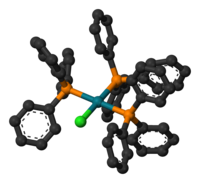
Photo from wikipedia
The catalytic activity of the binary composite catalysts of Fe2O3-CoO/CaA and Fe2O3-CoO/ZSM-5 was studied. They were obtained by impregnation of CaA and ZSM-5 zeolites with aqueous solutions of sulfates of… Click to show full abstract
The catalytic activity of the binary composite catalysts of Fe2O3-CoO/CaA and Fe2O3-CoO/ZSM-5 was studied. They were obtained by impregnation of CaA and ZSM-5 zeolites with aqueous solutions of sulfates of iron (FeSO4·7H2O) and cobalt (CoSO4·7H2O). The total metal content was no more than 5%. Then, oxidizing burning at 720 °C for 60 min was performed to produce the metal oxides. It was found that the obtained Fe-Co/CaA catalyst contains iron and cobalt as CoFe2O4 compound, and the Fe-Co/ZSM-5 catalyst includes CoFe2O4 and CoFe. The phase composition of the obtained catalysts was detected by the X-ray diffraction analysis. The surface morphology was investigated by the electron microscopy. The elemental composition of the obtained catalysts was determined by energy dispersive spectroscopy with mapping and inductively coupled plasma atomic emission spectroscopy. The atomic absorption analysis by the IR-spectroscopy showed the shifts of absorption bands in the infrared spectra of the pure zeolites and with added Fe and Co. The catalytic hydrogenation of anthracene was performed to determine the catalytic properties of the obtained catalysts. It is one of the most common model compounds applied to investigate the efficiency of catalytic systems. The result of hydrogenation found that conversion of anthracene at 400 °C, initial pressure of 6 MPa and duration of 60 min using the Fe-Co/CaA catalytic system equaled to ~87%. However, hydrogenation products equaled to ~84%. Anthracene conversion using the Fe-Co/ZSM-5 catalytic system and the same conditions was ~91%; among them, hydrogenated derivatives were ~71%. The proposed method is characterized by its simple execution. The obtained catalysts are be slightly inferior to platinum and rhodium catalysts in the catalytic activity.
Journal Title: Catalysts
Year Published: 2023
Link to full text (if available)
Share on Social Media: Sign Up to like & get
recommendations!